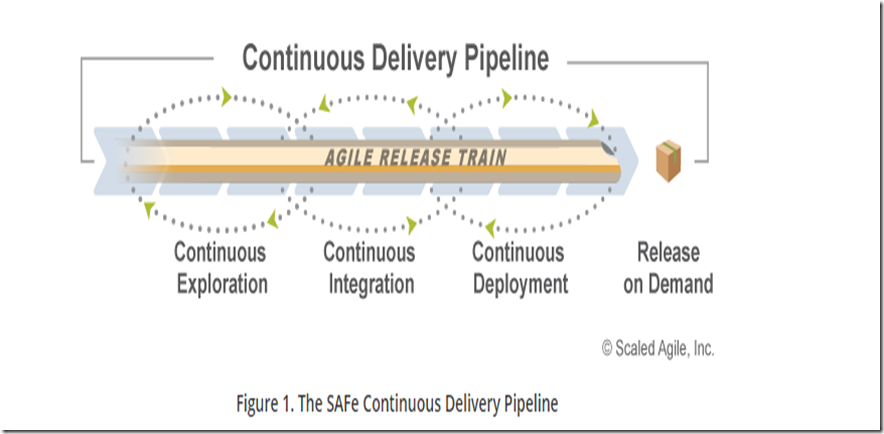Agile versus Scrum versus SAFe–Some notes
Agile is a development methodology – without a specific implementation. Prior to agile, developers worked in silos without cross collaboration. Agile introduced cross functional teams as well as concepts like automated testing.
Scrum is a popular implementation consisting of Sprints.
SCRUM sprints correspond to AGILE iterations.
Kanban – Introduces WIP (Work in Progress) to Scrum
You can apply Kanban principles to any process you are already running (even to Scrum ).
- In Kanban, you organize your work on a Kanban board. The board has states as columns, which every work item passes through – from left to right.
- You pull your work items along through the in progress, testing, ready for release, and released columns. And you may have various swim lanes – horizontal “pipelines” for different types of work.
- The only management criteria introduced by Kanban is the so called “Work In Progress (WIP)”. By managing WIP you can optimize flow of work items. Besides visualizing work on a Kanban board and monitoring WIP, nothing else needs to be changed to get started with Kanban.
SAFe – The Reason for it’s evolution –
The idea of cataloging a team’s complexities and having reusable patterns with which to solve them is a cornerstone of the Agile Scaling Model.
Lean versus Agile
Agile is a manifesto
- Individuals and interactions over processes and tools
- Working software over comprehensive documentation
- Customer collaboration over contract negotiation
- Responding to change over following a plan
Lean comes from Lean Manufacturing – and explains the workings behind agile practices.
- Eliminate Waste
- Deliver Fast
- Build Quality
- Respect People
- Create Knowledge
SAFe: Consists of Value Stream (Office, Windows…) –> Epics (Release Trains) > Capability (Features) > Feature > Story (Story) –> Task. These, along with Nonfunctional Requirements (NFRs), are the Agile requirements (system behavioral) artifacts that are used to define system and Solution Intent.
Stories – Are user stories (Customer creates new account) and enabler stories (create OO hierarchy for Accounts )
Iteration Goals are defined in terms of points and velocities. Typically a work day (8 hours) translates to 8 points (team points). Start with a small story (say an 8 point story is small). Use that as the reference. Now, assign total points to the various stories and tasks in the iteration. Initial Velocity – Final Velocity. Revisit in the ‘Iteration Retrospective’x
SAFe – Lean
Simply, lean means creating more value for customers with fewer resources. The ultimate goal is to provide perfect value to the customer through a perfect value creation process that has zero waste.
- Decentralize decision-making
- Help in building Agile Milestones and Roadmaps, as well as the building plans that enable them Help develop, implement, and communicate the economic framework.
- Participate in Inspect and Adapt workshops; support teams by helping them remove systemic impediments and implementing continuous improvement backlog items
- Protect teams from distractions and unrelated or unnecessary work Assist the Release Train and Solution Train Engineers with PI Planning readiness and Pre- and Post- PI Planning activities
- Participate in PI planning, System Demo, and Solution Demo Build partnerships with Suppliers, subcontractors, consultants, partners, and internal and external stakeholders
- Provide other resources as necessary for teams and ARTs to successfully execute their Vision and roadmap
- Reinforce the Essential SAFe practices Identify delays in the system by facilitating or participating in value stream mapping
SAFe Architectural Runway
is the existing technical infrastructure, instantiated in code, necessary to support the implementation of upcoming features without excessive, delay-inducing
SAFe Agile Release Train ( ART ) and Value Streams
Agile Release Train (ART) builds and maintains (or shares), a pipeline with the assets and technologies needed to deliver solution value as independently as possible. The first three elements of the pipeline work together to support delivery of small batches of new functionality, which are then released in accordance with market demand.
An ART can have multiple value streams
| SAFe Stories | SAFe Continuous Delivery | |
 |
 |
SAFe Level of Complexity
- The highest level of complexity is called Agility@Scale (A@S)
- the middle level is his well-known Disciplined Agile Delivery (DAD);
- The lowest level of complexity is Core Agile, which is basically scrum.
SAFe Limitations
SAFe does not provide any guidance for a few of the other A@S factors—specifically, geographical distribution, organizational complexity, compliance requirement, domain complexity, and organizational distribution.
TOGAF versus Agile
- Agile’s mission includes individuals and interactions over processes and tools. EA ( TOGAF ) is all about the process.
- Agile – early and continuous delivery – constant customer demos. TOGAF – phases – but not necessarily demos at the end of each phase
- Agile starts where EA ends. TOGAF is not necessarily waterfall
- TOGAF can add vision to Agile
Overlap between EA and Agile
- Iterative,
- Collaborative,
- Soft Skills
ITIL versus SDLC (Plan, design, implement, test, improve)
IT Information Library it has supported the idea of the delivery of the IT infrastructure as a set of IT Services as opposed to the individual hardware and software components that make up those services. The right question is not which method or process framework to use, but rather how to integrate SDLC-enabled activities in support of systems development in the larger context of the IT Service Lifecycle.
Leave a Reply